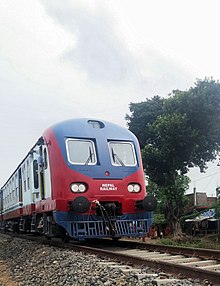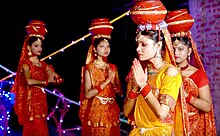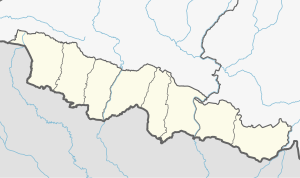Madhesh Province
Madhesh Province
मधेश प्रदेश Madhēśa pradēśa | |
|---|---|
|
Clockwise from top:Janaki Mandir,Gateway of NepalBirgunj,Gadhimai Temple,Chinnamasta Bhagawati TempleandKankalini Temple | |
 Location of Madhesh Province | |
Map of Madhesh Province, Nepal | |
| Province of | |
| Formation | 20 September 2015 |
| Capital city | Janakpur[1] |
| Largest city | Birgunj |
| Government | |
| • Type | Autonomy |
| • Body | Government of Madhesh Province |
| •Governor | Hari Shankar Mishra[2] |
| •Chief Minister | Satish Kumar Singh |
| • High Court | Janakpur High Court |
| •Provincial Assembly | Unicameral(107 seats) |
| •House of Representatives | 32 constituencies |
| Area | |
| • Total | 9,661 km2(3,730 sq mi) |
| Population (2021[3]) | |
| • Total | 6,114,600 |
| • Density | 630/km2(1,600/sq mi) |
| Time zone | UTC+5:45(Nepal Time) |
| Area code(s) | 041,031,033,046,053,051,044,055 |
| ISO 3166 code | NP-P2 |
| Official Languages | Nepali(co-official) andMaithili(official) |
| HDI | 0.519 (low) |
| Literacy | 63.5% |
| Sex ratio | 100.55 ♂ / 100 ♀ (2021) |
| GDP | US$ 5.6 billion (2023/2024) |
| Per Capita Income | US$ 892 |
| Website | madhesh |
Madhesh Provinceis aprovince of Nepalin theTerairegion with an area of 9,661 km2(3,730 sq mi) covering about 6.5% of the country's total area. It has a population of 6,126,288 as per the2021 Nepal census,making it Nepal's most densely populated province and the smallest province by area.[4][5] It bordersKoshi Pradeshto the east and the north,Bagmati Provinceto the north, andIndia’sBiharstate to the south and the west. The border betweenChitwan National ParkandParsa National Parkacts as the provincial boundary in the west, and theKosi Riverforms the provincial border in the east. The province includes eight districts, fromParsain the west toSaptariin the east.
It is a centre for religious and cultural tourism.[6]
Etymology
[edit]The wordmadheshis thought to be derived from theSanskritmadhya desh(मध्य देश), literally the middle country, which refers to "the central region, the country lying between the Himalaya and theVindhya mountains".[7][8]However, in the context of Nepal,Madheshrefers to the region in the Nepal Terai located south of theSiwalik Hills.[9][10] Madhesh has also been defined as the cultural and linguistic space existing as a basis for identity among the people of the Terai.[11]
History
[edit]Madhesh Province was founded with the provisional name Province No. 2 in September 2015 in accordance with Schedule 4 of the Constitution of Nepal.[12]It received its current name on 17 January 2022, when the provincial assembly declaredJanakpuras its capital.[13]
Demographics
[edit]According to the 2021 Nepal census, the province has a population of 6,114,600: 3,065,751 males and 3,048,849 females. The province with 20.97% of the country's population has the second-highest population afterBagmati Provincein the country, and is the densest province in the country with a density of 633 people per square kilometre.[3]
Ethnic groups
[edit]Maithilsare the largestethnolinguistic group.Yadavis the largest group among the Madhesi people in the province making up around 15.2% of the population.Muslimsare the second largest group making up 12.9% of the population.Teli(5.10%),Koiri/Kushwaha(4.56%),Chamar(4.22%),Musahar(3.02%),Kurmi(2.83%),Dusadh(2.79%),Mallaah(2.26%),Maithil Brahmin(2.2%), andKaran Kayastha(1.5%) are other Madhesi pandit (8.0) groups in the province.BahunandChhetriare the largestKhas Aryagroups in the province making up 2.34% and 1.99% of the population, respectively.Tharu(5.27%) andDhanuk(3.49%) is the largest non-Madhesi, non-Khas Arya group followed byTamang(2.17%).[14]
Languages
[edit]TheMaithili languageis spoken by 45.36% of the total population of the province.Bhojpuriis spoken by 18.59% andBajjikais spoken by 14.68% of the population. Despite being the province's official language,Nepaliis spoken as mother tongue by only 6.56% of the population.Urdu(5.88%),Tharu(3.77%), andTamang(1.94%) are other languages spoken by a minority of the population.[14] TheLanguage Commission of Nepalhas recommended Maithili, Bhojpuri, and Bajjika as official languages of the province. The commission has also recommended Urdu, Tharu, and Tamang to be additional official languages, for specific regions and purposes in the province.[15]
Religion
[edit]Hinduismis the most followed religion in the province, being followed by 83.75% of the population.Islamis the second largest religion with 12.9% of the population being Muslims, andBuddhismis followed by 3.01% of the population.[14]
Geography
[edit]As per Central Bureau of Statistics, Madhesh Province covers about 9,661 km2(3,730 sq mi) of Nepal's total area of 147,516 km2(56,956 sq mi). With 6,114,600 inhabitants as of 2021, it is Nepal's second most populous province.[3][16] Madhesh Province is surrounded by theChitwan Districtto the west,Makwanpur DistrictandSindhuli DistrictandUdayapur Districtto the north,Sunsari Districtto the east, andIndiato the south.[17] It is located in theInner Terai Valleys of Nepal.Koshi Riveron its eastern side is a natural border withKoshi Province.Madhesh Province has eight districts. Koshi River,Bagmati River,Kamla River,Lakhandei RiverandBishnumati Riverare the main rivers of the province.[citation needed]
The province has 574,360 hectares ofarable land,making it the country's most agriculture-dominated province. The west of the province contains part ofParsa National Park,while part ofKoshi Tappu Wildlife Reservelies within the east. The province is biodiverse, and is crossed by migrating elephants.[18]
| Rank | District | Pop. | Rank | District | Pop. | ||||
|---|---|---|---|---|---|---|---|---|---|
 Birgunj  Janakpur |
1 | Birgunj | Parsa | 240,922 | 11 | Bardibas | Mahottari | 66,354 |  Kalaiya  Jeetpur Simara |
| 2 | Janakpur | Dhanusha | 159,468 | 12 | Ishwarpur | Sarlahi | 59,986 | ||
| 3 | Kalaiya | Bara | 123,659 | 13 | Lalbandi | Sarlahi | 59,395 | ||
| 4 | Jeetpur Simara | Bara | 117,496 | 14 | Jaleshwor | Mahottari | 58,549 | ||
| 5 | Lahan | Siraha | 91,766 | 15 | Mahagadhimai | Bara | 54,474 | ||
| 6 | Siraha | Siraha | 82,531 | 16 | Golbazar | Siraha | 51,137 | ||
| 7 | Chandrapur | Rautahat | 72,059 | 17 | Garuda | Rautahat | 50,481 | ||
| 8 | Barahathwa | Sarlahi | 69,822 | 18 | Mirchaiya | Siraha | 50,079 | ||
| 9 | Rajbiraj | Saptari | 69,086 | 19 | Simraungadh | Bara | 49,939 | ||
| 10 | Gaushala | Mahottari | 66,673 | 20 | Manara Shiswa | Mahottari | 49,692 | ||
Climate
[edit]| Location | August
(°F) |
August
(°C) |
January
(°F) |
January
(°C) |
Annual
Precipitation (mm/in) |
|---|---|---|---|---|---|
| Gaur | 91/77.9 | 23/9.1 | 73.4/48.4 | 32.8/25.5 | 1590.2/62.6 |
| Siraha | 89.6/76.3 | 32/24.6 | 72.1/47.3 | 22.3/8.5 | 1293.1/50.9 |
| Birgunj | 84.7 | 29.3 | 60.8 | 16 | 1862.2/73.3 |
| Jaleshwar | 84.4 | 29.1 | 61.2 | 16.2 | 1492.9/58.8 |
| Malangawa | 84.4 | 29.1 | 60.8 | 16 | 1817.7/71.6 |
| Janakpur | 84.2 | 29 | 60.8 | 16 | 1516.5/59.7 |
| Rajbiraj | 83.3 | 28.5 | 60.4 | 15.8 | 1223.3/48.2 |
| Lahan | 83.3 | 28.5 | 60.3 | 15.7 | 1231.4/48.5 |
Government and administration
[edit]Executive
[edit]The Governor acts as the head of the province while the Chief Minister is the head of the provincial government. The present Governor and Chief Minister areHari Shankar MishraandSatish Kumar Singhrespectively.
Legislative
[edit]The province has 107provincial assembly constituenciesand 32 constituencies.[20]
Madhesh Province has aunicamerallegislature, like all of the other provinces in Nepal. The term length of provincial assembly is five years. TheProvincial Assembly of Madhesh Provinceis temporarily housed at the District Education Office inJanakpur.[21]
| Party | Parliamentary party leader | Seats | |
|---|---|---|---|
| People's Socialist Party, Nepal | Mohammad Lalbabu Raut | 39 | |
| Nepali Congress | Ram Saroj Yadav | 22 | |
| Loktantrik Samajbadi Party, Nepal | Jitendra Prasad Sonal | 16 | |
| CPN(Unified Socialist) | Satrudhan Mahato | 13 | |
| CPN(UML) | Satya Narayan Mandal | 8 | |
| CPN(Maoist centre) | Bharat Sah | 8 | |
| Nepal Federal Socialist Party | Sabitri Devi Shah | 1 | |
| Total | 107 | ||
Judiciary
[edit]The Chief Judge of the Janakpur High Court is the head of the judiciary.[22]The acting chief justice is Binod Sharma.[23]
Administrative subdivisions
[edit]Madhesh Province is divided into eight districts, which are listed below. A district is administrated by the head of theDistrict Coordination Committeeand the District Administration Officer. The districts are further divided into municipalities or rural municipalities. The municipalities include one metropolitan city, three sub-metropolitan cities, and 73 municipalities. There are 59 rural municipalities in the province.[24]
| Name | Headquarters | Population (2011) |
|---|---|---|
| Dhanusha District | Janakpur | 754,777 |
| Sarlahi District | Malangawa | 769,729 |
| Bara District | Kalaiya | 687,708 |
| Rautahat District | Gaur | 686,722 |
| Saptari District | Rajbiraj | 639,284 |
| Siraha District | Siraha | 637,328 |
| Mahottari District | Jaleshwar | 627,580 |
| Parsa District | Birgunj | 601,017 |
Infrastructure
[edit]This sectionneeds additional citations forverification.(January 2023) |
Transport
[edit]
Madhesh Province has no difficult terrains which seems to be good for infrastructure development however it is prone to flooding and submerging. It is the only province with a passenger serviceable railway line in Nepal.
Roadways
[edit]The major connecting link for the province is theMahendra Highway,which runs longitudinally across the province. All major cities of the province remain disconnected from this highway.Janakpurdham,Rajbiraj,BirgunjandGaurlie 25,10, 24 and 42 kilometres south of theMahendra Highway,respectively.[25]TheTribhuvan Highwaydoes not cross as much of the province as theMahendra Highway,but it is most important link as it connects the province toKathmanduand to theIndia.[26]The starting point ofTribhuvan Highwayi.e.Birgunjis the most important International Gateway and trade way for this province and entire country and hence known as "The Gateway of Nepal". In terms of revenue generation,Birgunjcustom point is the largest. Birendra Highway which is connected to Mahendra highway from Headquarter ofRautahatdistrictGaurto theChandranigahapuris 42 km (26 mi) in length.
- Mahendra Highway(East West Highway) - Part
- Postal Highway- Part
- Tribhuvan Highway- Part
- BP Highway- part
Railways
[edit]
A few other railway projects are under progress in the Madesh province All these projects are ofNepal Railways.Government of Nepal has proposed Janakpur as a Main Station for 1024 km east–west Metro Railway project and further be extended toIndiaand China for connectingNepal RailwayswithIndian RailwaysandChina Railwayfor business and tourism promotion.[27]
- Birgunj(Nepal) toKathmandu(Nepal)
- Birgunj,Parwanipur(Nepal) toRaxaul(India)
- Birgunj(Nepal) toKerung(China)
- Janakpur(Nepal) toLhasa(China)
- Bardibas,Janakpur(Nepal) toJainagar, Bihar(India)
- Janakpur(Nepal) toKathmandu(Nepal)
- Janakpur(Nepal) toBiratnagar(Nepal)
- Janakpur(Nepal) toBirgunj(Nepal)
Domestic Airports: Madhesh province has three domestic airports in use which are the busiest among the country.
- Rajbiraj AirportinRajbiraj
- Janakpur AirportinJanakpur
- Simara AirportinPipara Simara(BARA) close to Birgunj and Kalaiya
International Airport:
- Nijgadh International AirportinNijgadhis under construction.
Culture
[edit]This sectionneeds additional citations forverification.(January 2023) |
Mithila Paag
[edit]
ThePaagis a headdress in theMithila regionofNepalandIndiaworn byMaithilpeople. It is a symbol of honour and respect and a significant part ofMaithil culture.The Paag dates back to pre-historic times when it was made of plant leaves. It exists today in a modified form. The Paag is wore by the whole Maithil community. The colour of the Paag also carries a lot of significance. The red Paag is worn by thebridegroomand by those who are undergoing thesacred thread rituals.Paag of mustard colour is donned by those attending wedding ceremonies and the elders wear a white Paag.
Paintings
[edit]
Madhubani artis practiced in theMithilaregion. It was traditionally created by the women of different communities of the Mithila region.[28]This painting as a form of wall art was practiced widely throughout the region; the more recent development of painting on paper and canvas originated among the villages around Madhubani, and it is these latter developments that may correctly be referred to asMadhubani art.[29]

Artists create these paintings using a variety of mediums, including their own fingers, or twigs, brushes, nib-pens, and matchsticks. The paint is created using natural dyes and pigments. The paintings are characterised by their eye-catching geometrical patterns.
Cuisine
[edit]Maithil cuisine andBhojpuri cuisineare part ofNepalese cuisine.Maithil is a culinary style which originated in Mithila while Bhojpuri cuisine originated in the Bhojpuri region.[30]Some traditional dishes of Madhesh are:
- Curd-flattened rice
- Litti Chokha[31]
- Vegetable ofTaro
- Ghugni
- picklesmade of fruits and vegetables which are generally mixed with ingredients like salt, spices, and vegetable oils and are set to mature in a moistureless medium.
- Tarua ofCoccinia grandis
- Bada
- Badee
- Yogurt
- Irhar
- Pidukia (also known asGujia) which is basically dumplings.
- Foxnutpayas
- Anarsa
- Bagiya
Dances
[edit]Jhijhiya
[edit]Jhijhiya is a cultural dance from theMithila region.[32]

Jhijhiya is mostly performed at time ofDusshera,in dedication to DurgaBhairavi,the goddess of victory.[33]While performing jhijhiya, women put lanterns made of clay on their head and they balance it while they dance.[34]
Domkach
[edit]Domkach is a folk dance performed inMithilaandBhojpurregions of Madhesh Province.[35]
Jat Jatin
Jat Jatin is based on folk songs of Mithila and Tharu community which they perform from Shrawan Purnima to Bhadra Purnima. It is based on the love story of hero jat and heroine Jatin and their lives.[36]
Gauna dance
The Dance is based in Mithila Tradition and popular in Janakpur region of Nepal. This dance is performed in the religious occasions.
Politics
[edit]As a political center of the country, Madhesh Province is home to prominent leaders likeRam Baran Yadav,Bimalendra NidhiandPradeep Girifrom theNepali Congress,Mahantha ThakurfromLoktantrik Samajwadi Party, Nepal,Matrika YadavfromCPN (Maoist Centre)andDharmanath Prasad Sah,Bansidhar Mishra,Ram Chandra Jhafrom theCPN (Unified Socialist)who have been ministers at various point of time and are still active at National level.[37]In local level,Nepali congressremains the single largest party.[38]
Notable people
[edit]- Ruby Rana,First Miss Nepal
- Ram Baran Yadav,First President of Nepal
- Bimalendra Nidhi,MP and Former deputy prime minister
- CK Raut,MP of Saptari and Head of Janamat party
- Madhav Kumar Nepal,Former Prime minister
- Upendra Yadav,Former Deputy Prime Minister and Foreign Affairs Minister
- VTEN,Rapper from Rautahat
- Pradeep Giri,Former socialist politician
- Bina Jaiswal,Nepalese Politician, Rastriya Prajatantra party
- Aashiq Ali Mikrani,martyr of the Terai/Madhesh movement
See also
[edit]- Provinces of Nepal
- List of districts in Nepal
- Mahendra Narayan Nidhi Awas Yojana
- Nepali Congress, Madhesh Province.
- Madhesh Province cricket team
References
[edit]- ^"प्रदेश २ को स्थायी राजधानी 'जनकपुरधाम' बहुमतले पारित!"(in Nepali).
- ^"Government recommends Hari Shankar Mishra as provincial chief of Province 2".The Kathmandu Post.16 August 2021.Retrieved16 August2021.
- ^abc"2021 Nepal census".Kathmandu, Nepal: Central Bureau of Statistics.
- ^"National Population and Housing Census 2011"(PDF).Central Bureau of Statistics. Archived fromthe original(PDF)on 1 August 2014.Retrieved1 March2014.
- ^"सबैभन्दा बढी जनसंख्या हुने प्रदेश मधेश".ekantipur(in Nepali).Retrieved26 January2022.
- ^Rastriya Samachar Samiti (2004)."More Indian tourists visit Janakpurdham".Himalayan Times, 17 January 2004.
- ^Kabir 2013,p. 11.
- ^Apte, V. S. (1957–1959)."मध्य madhya".Revised and enlarged edition of Prin. V. S. Apte's The practical Sanskrit-English dictionary.Poona: Prasad Prakashan.[permanent dead link]
- ^Mishra, R. (2007). "Sectional President's Address: Ethnicity and National Unification: The Madheshis of Nepal".Proceedings of the Indian History Congress.67:802–833.JSTOR44148000.
- ^"Nepal Conflict Alert".crisisgroup.org.2 September 2015.
- ^Singh, C. P. (2011). "Origin and Development of Madheshi Movement in Nepal".Proceedings of the Indian History Congress.72(Part II): 1047–1053.JSTOR44145716.
- ^"Formation of provinces in Nepal"(PDF).Office of Attorney General (Nepal).
- ^"Janakpurdham declared Province 2 capital (With video)".Nepal Press.2022.Retrieved17 January2022.
- ^abc"National Data Portal Nepal".Government of Nepal National Data.Retrieved26 December2020.
- ^"सरकारी कामकाजको भाषाका आधारहरूको निर्धारण तथा भाषासम्बन्धी सिफारिसहरू (पञ्चवर्षीय प्रतिवेदन- साराांश) २०७८"(PDF).Language Commission.Archived fromthe original(PDF)on 6 September 2021.Retrieved28 October2021.
- ^Law, G. (2015)."Provinces of Nepal".statoids.Retrieved23 February2018.
- ^"Big 3 draw new 7-province map".Republica.22 August 2015.Retrieved26 June2017.
- ^Abhaya Raj Joshi (13 November 2023)."Nepal's Madhesh province lacks in biodiversity research & conservation".Mongabay.Retrieved25 November2023.
- ^"Nepal Travel Weather Averages".Weatherbase.Retrieved28 April2018.
- ^"CDC creates 495 constituencies".The Himalayan Times.31 August 2017.Retrieved27 April2018.
- ^"First Provincial Assembly meeting begins in 4 provinces".The Kathmandu Post.Retrieved27 April2018.
- ^"High Courts get their chief judges".The Kathmandu Post.Retrieved27 April2018.
- ^"उच्च अदालत जनकपुर".Supreme Court Nepal.Retrieved17 January2022.
- ^"स्थानिय तह".103.69.124.141.Archived fromthe originalon 31 August 2018.Retrieved27 April2018.
- ^Reed, David (2002).The Rough Guide to Nepal.Rough Guides.ISBN9781858288994.
- ^"Highways in Nepal".Archived fromthe originalon 26 January 2010.
- ^"Nepal, India agree on five rail projects".Archived fromthe originalon 2 April 2015.Retrieved25 June2017.
- ^Madhubani Painting.Abhinav Publications. 2003. p. 96.ISBN9788170171560.Archivedfrom the original on 28 October 2017.Retrieved20 February2017.
- ^Carolyn Brown Heinz, 2006, "Documenting the Image in Mithila Art," Visual Anthropology Review, Vol. 22, Issue 2, pp. 5-33
- ^"The Story Behind Nepalese Cuisine And Dishes That Are Worth Trying".Slurrp.Retrieved4 December2023.
- ^Bhadani, Gangadhar (16 March 2017).Choice in Chaos: A Wikipedian'S Autobiography.Partridge Publishing.ISBN978-1-4828-8891-1.
- ^Nishi Sinha (1999).Tourism Perspective in Bihar.APH. p. 39.ISBN9788170249757.
- ^Punam Kumari (1999).Social and cultural life of the Nepalese.Mohit Publications.ISBN978-81-7445-092-0.Retrieved16 August2013.
- ^Nishi Sinha (1999).Tourism Perspective in Bihar.APH. p. 40.ISBN9788170249757.
- ^"Domkach".Folklibrary.Retrieved18 December2018.
- ^"Jat Jatin dance".
- ^Kumar, Mukesh Pokhrel and Ramesh (10 April 2021)."The Politics of Province 2".Retrieved28 July2021.
- ^Republica."NC poised to be the largest party in Province 2".My Republica.Retrieved28 July2021.
Works cited
[edit]- Gaige, F. H. (1975)."Migration into the Tarai".Regionalism and National Unity in Nepal(Second ed.). Delhi: Vikas Publishing House. pp. 58–86.
- Kabir, H. (2013).Education, Nationalism, and Conflict in Plural Society in Nepal: Terai Region in the Post-Maoist Context.Discussion Paper Series. Vol. 19. Hiroshima: Hiroshima University Partnership Project for Peace Building and Capacity Development.
- Pradhan, Kumar L. (2012),Thapa Politics in Nepal: With Special Reference to Bhim Sen Thapa, 1806–1839,New Delhi: Concept Publishing Company, p. 278,ISBN9788180698132












